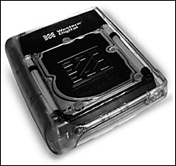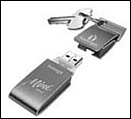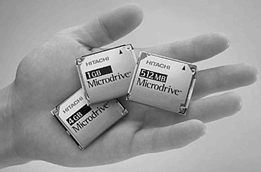Storage Devices
| There are numerous types of storage devices, from drives to memory cards that are as small as the tip of your thumb. The type of storage device you use depends on your needs. If you're looking for massive storage, you probably need an external hard drive. For more portable storage, however, you'll probably want to consider card-type storage media or USB key drives. Note
External USB 2.0 and FireWire Hard DrivesExternal USB and FireWire hard drives come in sizes ranging up to 250 GB, and will keep getting bigger. As digital media file collections grow, so too will the sizes of the storage equipment. Expect large external drives to remain the highest capacity options for storing and retrieving data well into the future. What to Look ForLook for USB 2.0 or FireWire, depending on which one your Tablet PC supports. Don't buy a USB 1.x drive even if your Tablet PC only handles USB 1.x. You might upgrade in the future, and your drive speed will remain slow. USB 2.0 is about 10 times faster than the previous version, and for data transfer, that's huge. Other things to look for are the size and portability of the drives. Most will require access to AC power (or you can use an inverter for access in your car). Caution
USB Flash DrivesUSB flash drives are small, highlighter-size memory devices that plug into a USB port. As of this writing, these devices enable you to store up to 4 GB of data. I'm sure that as they pack more on a chip, the sizes will grow. Some flash drives, such as the Gruvstick by CenDyne, or the MP3-BD256 by BUSlink, come with a built-in MP3 player and voice recorder, but most are just digital storage devices. What to Look ForAlthough USB 2.0 devices should be faster than 1.1 devices, they rarely are, because the speed to read and write non-volatile memory is much slower than reading from a hard drive. All the same, USB 2.0 devices may offer a bit of an advantage. Also look for any special features, such as MP3 playback, voice recording, and ActiveDisk support. ActiveDisk is something that the Iomega devices offer, which allows an application to run from the flash drive without being installed on the host machine. Not all applications support ActiveDisk, but many do.
Other Digital Media OptionsSecureDigital, CompactFlash, XD, Memory Stick, and CardBus are all different storage formats for non-volatile memory products that can store gigabytes of data in the palm of your hand. Many Tablet PCs offer direct access to these media devices. For example, my Toshiba Portégé 3500 has an SD card slot and a CompactFlash card slot in addition to the standard CardBus slot. If that sounds confusing, it is. No single media has taken hold of the industry. As usual, Sony is trying to take the market with its Memory Stick media, while other manufacturers support various other media. SD and XD cards are postage stamp sized solid-state memory cards. This means they can be thrown around without jarring any mechanisms, unlike small hard drives. What to Look ForIf you need some portable storage, the main thing to look for is capacity, and the format that is easiest for your Tablet PC and the recipient's machine to accept. This could be any of the media formats. Just realize that none of the solid state memory products are going to be as fast as a hard drive. Sounds crazy, but the technology limits the speed of access and writing. Writing is slower than reading on any of the media formats.
|
EAN: 2147483647
Pages: 172
- ERP System Acquisition: A Process Model and Results From an Austrian Survey
- The Effects of an Enterprise Resource Planning System (ERP) Implementation on Job Characteristics – A Study using the Hackman and Oldham Job Characteristics Model
- Context Management of ERP Processes in Virtual Communities
- Distributed Data Warehouse for Geo-spatial Services
- Data Mining for Business Process Reengineering




